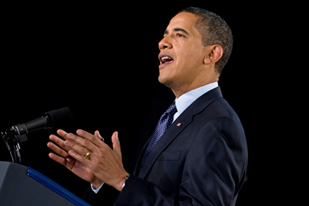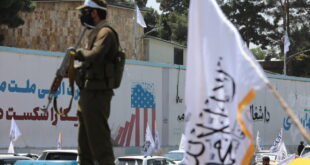 A key element of Obama’s plan is to erode militants’ power by strengthening local leaders, who can in turn provide incentives for foot soldiers to switch sides.
A key element of Obama’s plan is to erode militants’ power by strengthening local leaders, who can in turn provide incentives for foot soldiers to switch sides.
Reporting from Washington — The Obama administration’s plan to overhaul the Afghanistan war will include a reinvigorated effort to sap the strength and influence of Taliban leaders by luring away their foot soldiers, according to advisors involved in a painstaking strategy review.
The plan is based on the assumption that top leaders of extremist groups are unlikely to switch sides wholesale and would be unreliable allies if they did. Instead, the revised military effort will focus on eroding the power of militant leaders by drawing away low-level fighters — most of whom signed up for financial reasons.
The White House is nearing approval of the strategy and is expected to outline details next week, before President Obama travels to a summit of world leaders in early April.
The strategy review will address the need to build up the abilities of the central government and to expand the Afghan National Army. But many officials have concluded that local leaders and governments are even more important.
Under the plan, the administration would offer local leaders a variety of tools, including small-scale economic projects and training for local security forces, that they can use to convince insurgent fighters to lay down their weapons.
The plan and its objectives were described by advisors who spoke anonymously because the strategy review is not complete.
But the emphasis on local reconciliation reflects a growing belief that a heavy reliance on the country’s central government, led by President Hamid Karzai, has hindered the U.S.-led war effort.
U.S. Defense Secretary Robert M. Gates has been particularly critical of the focus on Kabul. Pentagon Press Secretary Geoff Morrell, while refusing to discuss the White House review, said Gates had been clear that the U.S. needed to do more to build up local governments.
“Building a strong central government in Afghanistan is counter-cultural, counter-historical,” Morrell said.
A crucial first step is to improve overall security. John Hutton, the British defense minister, said that the war was at a “stalemate” and the situation had to be improved as part of a new strategy.
“We have to invest time and effort in reconciliation,” Hutton said, “but ultimately it is better to negotiate from a position of strength rather than weakness.”
In coming months, 17,000 additional U.S. troops will arrive, increasing the American force to about 55,000.
For militant groups, much of their recruiting base comes from young men frustrated with their economic prospects.
Craig Mullaney, a former Army officer who served in Afghanistan and advised Obama’s Pentagon transition team, said he saw farmers in Gardez province accept $200 to fire a rocket at an American base, not because they supported the Taliban but because they needed the money.
“The Taliban gain traction because they feed on a lack of opportunity,” said Mullaney, author of “The Unforgiving Minute,” a memoir about Afghanistan and the military. “But we can give people an alternative.”
Mullaney said the U.S. can demonstrate its strength by wooing Taliban soldiers away from extremist leaders.
“You suffocate the enemy, you suck up their recruiting base,” he said. “It is an unconventional way of attrition.”
Military and administration officials have examined successful efforts to undermine militant groups. Many cite the work of Army Col. Christopher Kolenda, a battalion commander in Afghanistan from May 2007 to July 2008.
Working in northern Kunar and eastern Nuristan provinces, Kolenda’s forces used small-scale projects, including miniature hydroelectric plants, to help build up the local shuras, councils of tribal elders in the area. Those elders were then willing to pressure young people to stop working as paid fighters for insurgent leaders.
But in addition to the carrots, Kolenda’s unit, the 1st Squadron, 91st Cavalry of the 173rd Airborne Brigade, provided sticks.
“In every firefight, you punish the enemy,” Kolenda said in an interview this week. “There is nothing more demoralizing than getting clobbered for a cause you don’t believe in.”
Kolenda said it took six to nine months to undermine the base of militant support in an area. Long-term, he said, keeping young men away from insurgent groups requires greater economic opportunity.
But Mullaney said the military could get a big impact out of very small projects.
“The watchwords are think local and think small,” he said. “High-impact, high-efficiency, low-cost projects.”
 Eurasia Press & News
Eurasia Press & News


